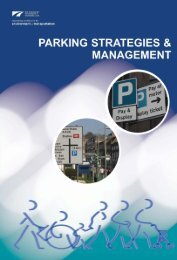Level 2 and 3 Diploma in Business Support (4475-12/13)
Level 2 and 3 Diploma in Business Support (4475-12/13)
Level 2 and 3 Diploma in Business Support (4475-12/13)
Create successful ePaper yourself
Turn your PDF publications into a flip-book with our unique Google optimized e-Paper software.
Unit 214 Database software<br />
<strong>Level</strong>: 2<br />
Credit value: 4<br />
UAN: M/502/4555<br />
Unit aim<br />
This is the ability to use a software application designed to organise <strong>and</strong> store structured<br />
<strong>in</strong>formation <strong>and</strong> generate reports.<br />
On completion of this unit a c<strong>and</strong>idate should be able select <strong>and</strong> use <strong>in</strong>termediate database<br />
software tools <strong>and</strong> techniques to:<br />
• enter <strong>in</strong>formation <strong>in</strong>to databases, that is at times non-rout<strong>in</strong>e or unfamiliar;<br />
• retrieve <strong>in</strong>formation by creat<strong>in</strong>g queries us<strong>in</strong>g multiple selection criteria; <strong>and</strong><br />
• produce reports by sett<strong>in</strong>g up menus or short cuts.<br />
They will also be able to create <strong>and</strong> modify s<strong>in</strong>gle table, non-relational databases. Any aspects that<br />
are unfamiliar may require support <strong>and</strong> advice from others.<br />
Database tools, functions <strong>and</strong> techniques will be described as ‘<strong>in</strong>termediate’ because:<br />
• the software tools <strong>and</strong> functions <strong>in</strong>volved will at times be non-rout<strong>in</strong>e or unfamiliar; <strong>and</strong><br />
• the choice <strong>and</strong> use of <strong>in</strong>put, manipulation <strong>and</strong> output techniques will need to take account of a<br />
number of factors or elements.<br />
Examples of context: Typical ‘more complex’ reports may be about – sales activities, order details<br />
or project management.<br />
Learn<strong>in</strong>g outcomes<br />
There are three learn<strong>in</strong>g outcomes to this unit. The learner will:<br />
1 Be able to create <strong>and</strong> modify non-relational database tables<br />
2 Be able to enter, edit <strong>and</strong> organise structured <strong>in</strong>formation <strong>in</strong> a database<br />
3 Be able to use database software tools to run queries <strong>and</strong> produce reports<br />
Guided learn<strong>in</strong>g hours<br />
It is recommended that 30 hours should be allocated for this unit, although patterns of delivery are<br />
likely to vary.<br />
Details of the relationship between the unit <strong>and</strong> relevant national occupational st<strong>and</strong>ards<br />
This unit is l<strong>in</strong>ked to the <strong>Level</strong> 2 IT User NOS devised by e-Skills UK.<br />
<strong>Support</strong> of the unit by a sector or other appropriate body<br />
This unit was developed by e-Skills UK.<br />
Assessment<br />
This unit will be assessed as specified <strong>in</strong> the e-Skills IT User Assessment Strategy 2009.<br />
<strong>Level</strong> 2 <strong>and</strong> 3 <strong>Diploma</strong> <strong>in</strong> Bus<strong>in</strong>ess <strong>Support</strong> (<strong>4475</strong>-<strong>12</strong>/<strong>13</strong>) <strong>12</strong>1







